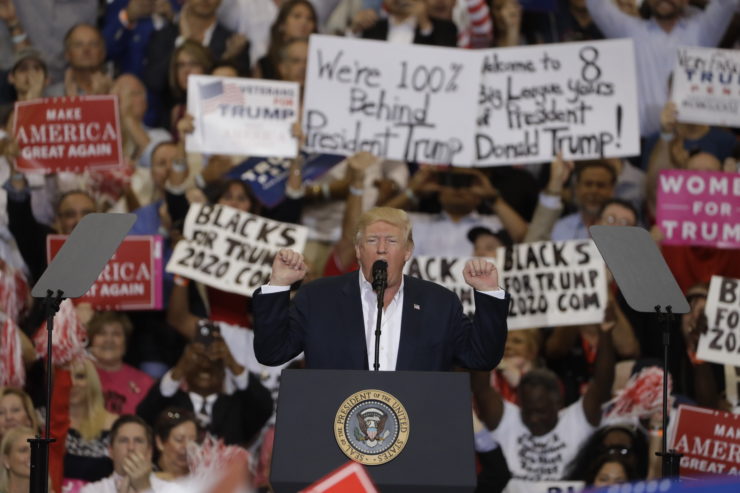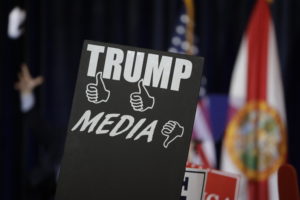
During a campaign rally on February 18 in Melbourne, Florida, President Donald Trump falsely indicated that a crime wave has swept Sweden as a result of the large number of refugees in the country
Swedes had a good laugh a few days ago when Donald Trump remarked that Sweden, which has accepted large numbers of refugees, “is having problems like they never thought possible.”
Sweden’s former Prime Minister Carl Bildt put it most succinctly, in a tweet about Trump: “What has he been smoking?”
Trump’s speech that Saturday, at a Melbourne, Florida rally, referred to “what’s happening last night in Sweden.” It turned out that, the night before, Trump had watched a Fox News segment that depicted Sweden as a war zone, being torn apart by an apocalyptic crime wave caused by Muslim refugees.
There was only one problem with the president’s source of information: The statistics on crime in Sweden do not support the filmmaker’s contention. The two policemen on whom the journalist Ami Horowitz had based his story say he completely twisted their words for his own ends.
“The interview was about something completely different to what Fox News and Horowitz were talking about,” police officer Anders Göranzon, one of the key sources for the show, told Swedish newspaper Dagens Nyheter. “[Horowitz] is a madman.”
The reason a small, prosperous, and largely peaceful country in Northern Europe caught the attention of the most powerful man in the world is simple: Sweden’s immigration policies aren’t consistent with his worldview and must therefore be smeared.
The political background is that Sweden in recent years has accepted a record number of refugees. These are men, women, and children who are victims of wars and conflicts that the United States in several cases initiated—but to whom it has closed its own borders. Seen from that perspective, the cynicism in Trump’s remark is just mind-boggling.
More importantly, this story is a perfect illustration of how the extreme right’s global information warfare works. Both my newspaper, Aftonbladet, and other Swedish media outlets have reported extensively on the connections between the Swedish right wing, its European counterparts, and Russian state propaganda.
The Fox segment that Trump had watched is a carbon copy of the image of Sweden that right-wing extremists have been peddling for a long time. The third-biggest party in the Swedish parliament is the “Sweden Democrats,” an organization with roots in the neo-Nazi movement. They have for years, purposefully and deliberately, built their own information and “media” channels. The content they produce looks like news, and their stories are shared widely on social media. But they have nothing in common with real journalism. The information is cherry-picked, the imagery racist, and the stories that don’t fit in will not get published.
It’s important to understand two things about how this type of propaganda works. First, the information networks of the far right are global and well-funded. The editors, content producers, and politicians in charge know and learn from each other.
Secondly, the content they produce is created for two very specific purposes: to foster racism and undermine democratic institutions. More specifically, they want to portray journalists as “enemies of the people,” just as Trump did the other day. If that succeeds, the road to a more ambitious dismantling of liberal democracy becomes easier.
Add to all this the fact that there are clear ties between Russia and the disinformation-campaigns from the extreme right in Europe. It makes sense, since these players share the common goal of destabilizing the institutions of liberal democracy. But it makes the level of irresponsibility from politicians riding this wave of propaganda even more shocking.
A couple of days after Trump’s remarks there was an outburst of violence in Rinkeby, a poor suburb outside of Stockholm. Had Trump not made reference to an incident “last night in Sweden,” no one outside of Sweden would have noticed. Suddenly routine crime was headline news. Now this gave new ammunition to the Sweden-haters at home and abroad.
The riots in Rinkeby had nothing to do with either Donald Trump or recent immigration to Sweden, but rather are the consequence of inequality, poverty, and long-term ethnic segregation. Yes, accepting a large number of refugees in a short period of time comes with challenges. I and many other Swedish journalists have written extensively about the social dangers of ethnic segregation and the need for investment in housing and education. Sweden is far from a perfect country. But there is no crime wave. Homicide rates are at the same levels as before the surge of refugees, and assaults have decreased.
Sweden is not going under and as late as January, the World Economic Forum wrote the story “Why Sweden Beats Other Countries at Just About Everything.”
But this is not the point here.
The point is that the U.S. president is echoing the misinformation of a global propaganda-machinery with close ties to Russia, connecting right-wing movements across the globe. That’s a story with much wider implications than Trump’s misstatements about what’s happening in Sweden.



